Sunday, July 05, 2009
Tuesday, March 17, 2009
Day 6 - Xian, 10 November 2006
We headed on the over night train to Shanghai. The trains have improved greatly in speed over the years. The Chinese, in their engineering inspiered designated lack of imagination (which I feel very comfortable with, being an engineer) call them various speed up versions, usually with some number. In fact, I often wondered if the top level brass in China did not rise up through the rail system. They spend a fortune on it.
Because the restaurant car was full, they brought the breakfast to our soft sleeper cabin. Ah, the posh joys of soft sleeper class.
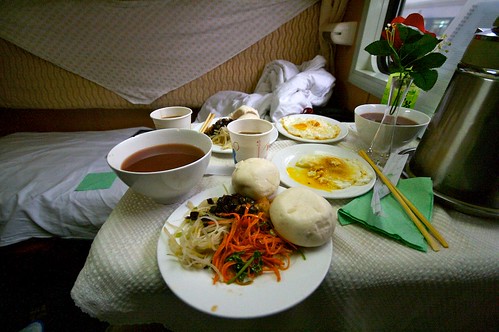
As we came into Shanghai, we passed though a land of canals.
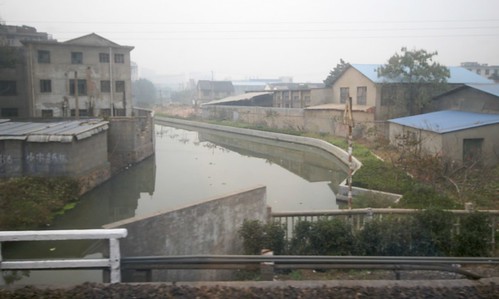





We then went to the our hotel and then along the bund. When I arrived in China the first time, I flew to Shanghai form HK and went along the bund with Barbara. It has changed in many ways, but in some way it has not changed at all. It is the latter I think that is very interesting. But I did not spend enough time in Shanghai, this third time to get a really good view of it. That is one of the drawbacks of travelling with others.
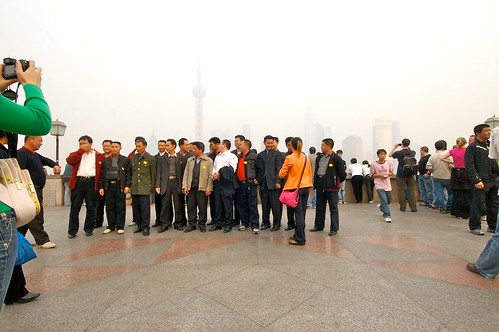
In this view of the over the river, when I visited in 1992, the communications tower (with the bulby bits) was only partly constructed. The entire rest of the scene was rice paddies.
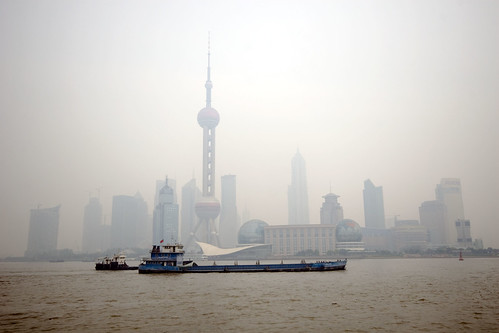





The amount of traffic on the main river seemed to be about the same, but the multi-barge flotillas were gone. I remember seeing trains of barges, with say 20 barges head to toe in a line. In the creek, the massive barge trains were gone.
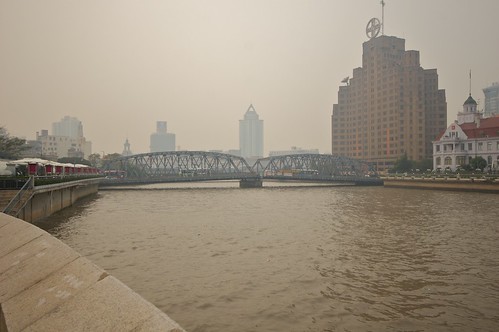





As I remember it, this building was the old Russian embassy, in the Russian quarter. The previous tow times I stayed in Shanghai I stayed in the backpackers behind the embassy.
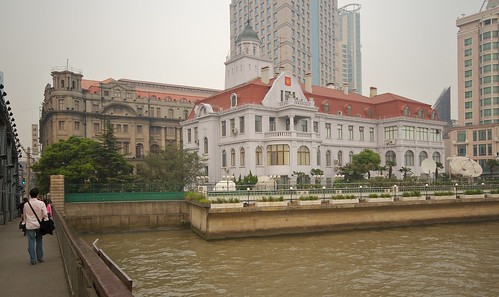





Bicycles, What I remember of Shanghai the first time was the bicycles, though there were very few compared to Nanjing. Today there are less bikes than ever. But occasionally you saw some.
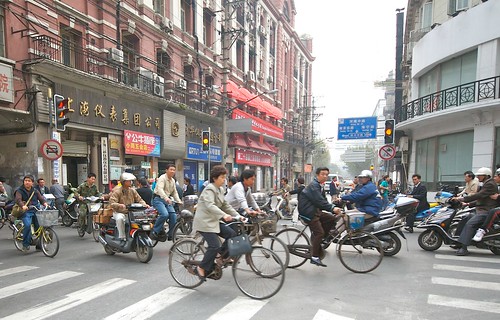
A before shot. I guess the trikes have gone and are replaced by mopes, electric bikes and scooters.
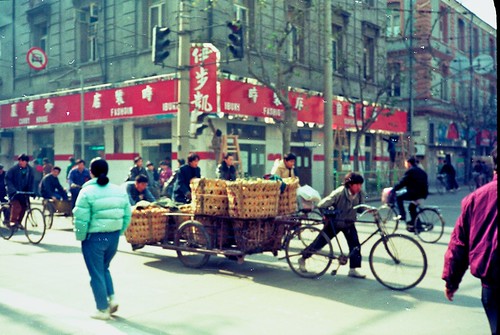
That night we went out on our most expensive night on town, I possibly have ever had. We went up to the a bar on the 88th floor of one of the buildings on the other side of the river. We had to take three lifts to get up there.
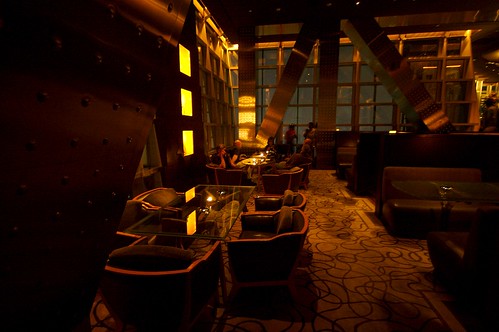





And then we went under the river by taxi to have dinner in the old French quarter.
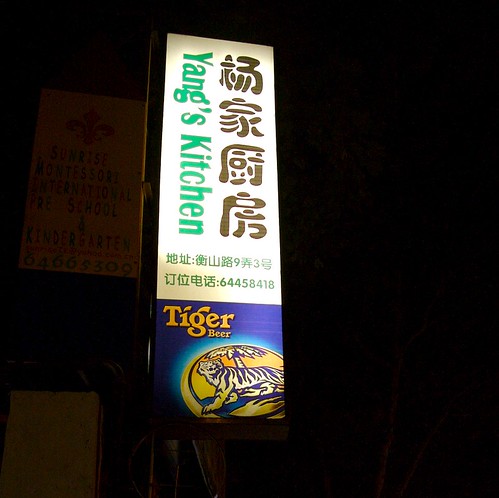
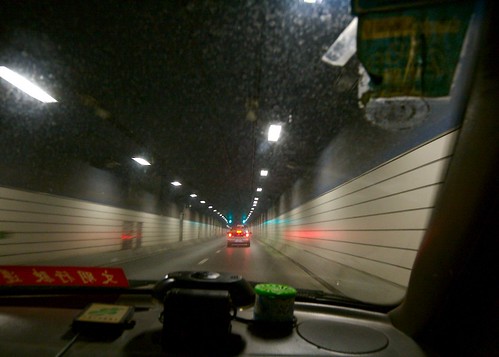
Because the restaurant car was full, they brought the breakfast to our soft sleeper cabin. Ah, the posh joys of soft sleeper class.

As we came into Shanghai, we passed though a land of canals.






We then went to the our hotel and then along the bund. When I arrived in China the first time, I flew to Shanghai form HK and went along the bund with Barbara. It has changed in many ways, but in some way it has not changed at all. It is the latter I think that is very interesting. But I did not spend enough time in Shanghai, this third time to get a really good view of it. That is one of the drawbacks of travelling with others.

In this view of the over the river, when I visited in 1992, the communications tower (with the bulby bits) was only partly constructed. The entire rest of the scene was rice paddies.






The amount of traffic on the main river seemed to be about the same, but the multi-barge flotillas were gone. I remember seeing trains of barges, with say 20 barges head to toe in a line. In the creek, the massive barge trains were gone.






As I remember it, this building was the old Russian embassy, in the Russian quarter. The previous tow times I stayed in Shanghai I stayed in the backpackers behind the embassy.






Bicycles, What I remember of Shanghai the first time was the bicycles, though there were very few compared to Nanjing. Today there are less bikes than ever. But occasionally you saw some.

A before shot. I guess the trikes have gone and are replaced by mopes, electric bikes and scooters.

That night we went out on our most expensive night on town, I possibly have ever had. We went up to the a bar on the 88th floor of one of the buildings on the other side of the river. We had to take three lifts to get up there.






And then we went under the river by taxi to have dinner in the old French quarter.


Saturday, January 31, 2009
On the cutural revolution
This will not be a detailed or complex history of the cultural revolution. But it is a somewhat personal view point of these events and the odd random things I have learned along the way, from the media and from being in China.
Before I first went to China in 1992, I knew about the cultural revolution only from the Australian Media. What I had seen on TV and in the news papers and what I had learned at school. I entered china without much of an interest to learn about the topic, and really this is where I still stand. But I am interested in such things from an anthropological and historical point of view. And I will talk of my view of others periods of china's history in latter posts.
When I went to China my view was that it was a period of great ferment. A period when the new Political landscape of China was formed and the old destroyed. It was a time of massive deaths, from political violence and starvation, of major blunders like the decision to kill the birds because they were eating the seeds.
What got me thinking about this time occurs in a little town call Leshan (乐山). In Leshan is the Leshan Giant Buddha (乐山大佛) and we visited it. We were told a story. Apparently a train of red guards left Beijing with the specific intent of destroying the Buddha. One of the leaders, Deng Xiaoping (I am stating this from memory, it was a long time ago) or perhaps some of his supporters were trying to stop these trians. They were successful with this train and it ended up in ChengDu. The red guards never made it to Leshan to destroy the Buddha. This was the first I had ever heard of decent from the top ranks of the party. I though, this does not sound like what I have been told it was. It sounds like a power struggle. But I put it to one side. There was too much to learn in China to ponder and I was not really interested in further investigation.
This was probably the only such event back in 1992. In the intervening time, I did read the odd thing with interest about the cultural revolution and started on the journey to my latter conclusions.
The next time I was in China was in 1999. In the interim time, Deng had died. One of the interesting things that happened, was that overnight tian-a-min square filled with flowers and tributes. The next day they were removed. The communists have never been happy acknolwledging Deng.
Back in China, I decided to learn a bit more about what the Chinese think of Mao. Well, seemingly he did not exist. There was just a mao shaped void. My chinese was not good enough and things were a bit tricky becuase of the NATO bombings of Serbia. So again I did not follow up. But more and more I was seeing the revolution as a political bun fight.
I travelled in China again in 2006, this time for 6 weeks and visited Manchuria as well as the places I had been before, Beijing, Xian, Shanghai (for the third time) and Yangshuo. When I was in Harbin, I found a statue of Mao, the first I had ever seen. I tried to take a photo, but was gently stopped by the guard on the gate. Apparently I was not allowed to take a photo of the defence HQ building behind the statue. But there was mao in the back blocks, a bit like the stautes of St Peter and Stalin in a park in the remoter parts of St Petersberg.
The only other reference I saw was a poster of Mao in a loung room in a village near Yang Shuo. I pointed out that I found the view of the Chinese towards mao ambivilent at the best. This caused the man who was eves dropping on us to leave the building. Very strange. I described the Chinese relationship towards Mao and the revolution as one of being like a bunch of Penguins. There are seals off the coast, they have eaten others. The chinese are standing on the edge, they know they need to take the leap. No one wants to be the first one to jump.
So here is my current consolidated view. I may come back from time to time if I find that there are gramatical errors that do not cause this to correctly present my point of view.
The chinese know what happened during the revolution, so does the party. The party does not want to talk about it because the party is full of gits who can't possibly admit that what they did was wrong becuase it would bring into question what they are doing. The people do not talk about it in the open becasue the party has secret police everywhere and if they did, they would likely end up in jail or perhaps be killed. So there is this silence, nobody talks about it. Every one who is not a vendor selling trinkets to foreign tourists wishes the whole mess would go away and help the forgetting by pretending that mao was just some kind of bad dream. The only people who hold mao in esteem are foreigners where he has pop icon status.
I veiw the cultural revolution as a continuation of the civil war. After the communists won, there seems to be a period of relative calm while they got over the victory and getting back into running the country. But China is not a democracy. It is an Autocracy. This means that it works more like a feudal system and the way to power is to get rid of your opponents. The Cultural Revolution was Mao and his sides attempt to remove the opposition from within the party. They used the chaos of the revolution to allow them to run roughshod over any processes and do what they wanted. The reason his opponents like deng are so loved is that they fought this and tried to protect china. Even until the end Mao's wife saw Deng as her biggest threat. I suspect that this power struggle also has something to do with the split with the Soviet Union. Perhaps Mao's opponents were the ones who had the Soviet's support. This means that the civil was did not really end until the execution of the gang of four.
What I am really interested in learning is what people learned in school of this time, most particularly those in China. So if you have any stories, feel free to add them here, no matter how mundane they may sound to you.
Before I first went to China in 1992, I knew about the cultural revolution only from the Australian Media. What I had seen on TV and in the news papers and what I had learned at school. I entered china without much of an interest to learn about the topic, and really this is where I still stand. But I am interested in such things from an anthropological and historical point of view. And I will talk of my view of others periods of china's history in latter posts.
When I went to China my view was that it was a period of great ferment. A period when the new Political landscape of China was formed and the old destroyed. It was a time of massive deaths, from political violence and starvation, of major blunders like the decision to kill the birds because they were eating the seeds.
What got me thinking about this time occurs in a little town call Leshan (乐山). In Leshan is the Leshan Giant Buddha (乐山大佛) and we visited it. We were told a story. Apparently a train of red guards left Beijing with the specific intent of destroying the Buddha. One of the leaders, Deng Xiaoping (I am stating this from memory, it was a long time ago) or perhaps some of his supporters were trying to stop these trians. They were successful with this train and it ended up in ChengDu. The red guards never made it to Leshan to destroy the Buddha. This was the first I had ever heard of decent from the top ranks of the party. I though, this does not sound like what I have been told it was. It sounds like a power struggle. But I put it to one side. There was too much to learn in China to ponder and I was not really interested in further investigation.
This was probably the only such event back in 1992. In the intervening time, I did read the odd thing with interest about the cultural revolution and started on the journey to my latter conclusions.
The next time I was in China was in 1999. In the interim time, Deng had died. One of the interesting things that happened, was that overnight tian-a-min square filled with flowers and tributes. The next day they were removed. The communists have never been happy acknolwledging Deng.
Back in China, I decided to learn a bit more about what the Chinese think of Mao. Well, seemingly he did not exist. There was just a mao shaped void. My chinese was not good enough and things were a bit tricky becuase of the NATO bombings of Serbia. So again I did not follow up. But more and more I was seeing the revolution as a political bun fight.
I travelled in China again in 2006, this time for 6 weeks and visited Manchuria as well as the places I had been before, Beijing, Xian, Shanghai (for the third time) and Yangshuo. When I was in Harbin, I found a statue of Mao, the first I had ever seen. I tried to take a photo, but was gently stopped by the guard on the gate. Apparently I was not allowed to take a photo of the defence HQ building behind the statue. But there was mao in the back blocks, a bit like the stautes of St Peter and Stalin in a park in the remoter parts of St Petersberg.
The only other reference I saw was a poster of Mao in a loung room in a village near Yang Shuo. I pointed out that I found the view of the Chinese towards mao ambivilent at the best. This caused the man who was eves dropping on us to leave the building. Very strange. I described the Chinese relationship towards Mao and the revolution as one of being like a bunch of Penguins. There are seals off the coast, they have eaten others. The chinese are standing on the edge, they know they need to take the leap. No one wants to be the first one to jump.
So here is my current consolidated view. I may come back from time to time if I find that there are gramatical errors that do not cause this to correctly present my point of view.
The chinese know what happened during the revolution, so does the party. The party does not want to talk about it because the party is full of gits who can't possibly admit that what they did was wrong becuase it would bring into question what they are doing. The people do not talk about it in the open becasue the party has secret police everywhere and if they did, they would likely end up in jail or perhaps be killed. So there is this silence, nobody talks about it. Every one who is not a vendor selling trinkets to foreign tourists wishes the whole mess would go away and help the forgetting by pretending that mao was just some kind of bad dream. The only people who hold mao in esteem are foreigners where he has pop icon status.
I veiw the cultural revolution as a continuation of the civil war. After the communists won, there seems to be a period of relative calm while they got over the victory and getting back into running the country. But China is not a democracy. It is an Autocracy. This means that it works more like a feudal system and the way to power is to get rid of your opponents. The Cultural Revolution was Mao and his sides attempt to remove the opposition from within the party. They used the chaos of the revolution to allow them to run roughshod over any processes and do what they wanted. The reason his opponents like deng are so loved is that they fought this and tried to protect china. Even until the end Mao's wife saw Deng as her biggest threat. I suspect that this power struggle also has something to do with the split with the Soviet Union. Perhaps Mao's opponents were the ones who had the Soviet's support. This means that the civil was did not really end until the execution of the gang of four.
What I am really interested in learning is what people learned in school of this time, most particularly those in China. So if you have any stories, feel free to add them here, no matter how mundane they may sound to you.
Monday, December 08, 2008
Day 5 - Xian, 9 November 2006
As a group we headed out of the south gate and along the wall of the city. Being in the lead, I came across a group of musicians sitting and chatting in a pagoda. As I started taking photos, they came to an agreement and started setting up. They soon launched into a folk tune and this attracted all the others. There were a few other groups further along the wall. Always older people. There were not very many people in the park at this time.
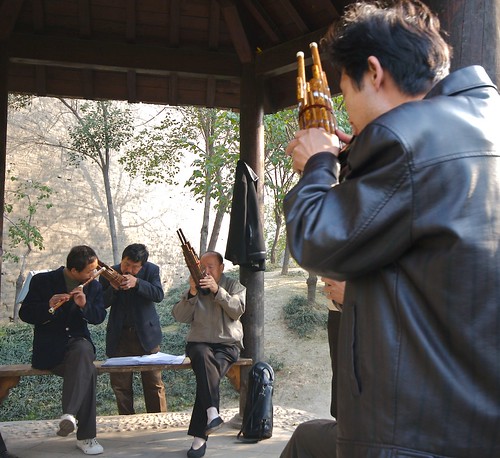





We then headed back into Xian via the south gate, to the calligraphy market. By this time I had split off from most of the rest of the group and at the end of the market I headed off on my own. This part of town is still quite touristy.
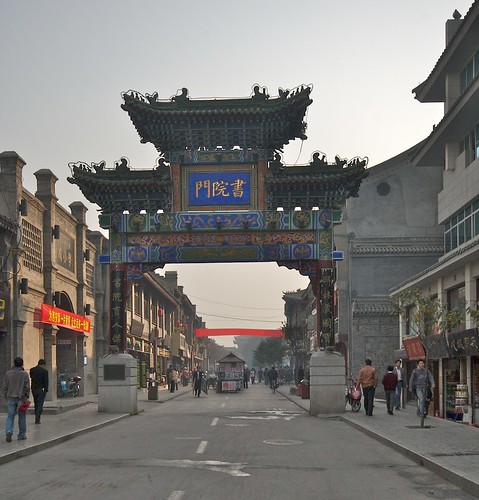





I wound my way along the inside of the east wall, and up to the east gate. As I passed a hair dresser's I caused quite a stir with my long, unkept hair. I should have stopped for a hair cut.
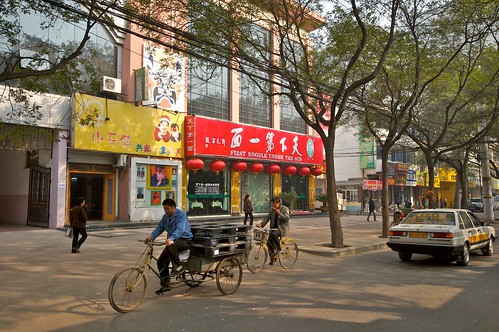





Passing out through the gate, I wandered through the back streets. I was impressed again to see how far china has come. I saw my first cement truck in China. I remembered many years ago, watching a road be built in Le Shan in Sze Chuan province. There must have been at least 100 men. There were men shovelling the sand, screening and concrete into little mixers, much smaller than the one on a concrete truck. More men, took this away in wheel barrows, while others used trowels to put the concrete onto the road. The white lines were hand layed tiles. It was amazingly labour intensive.
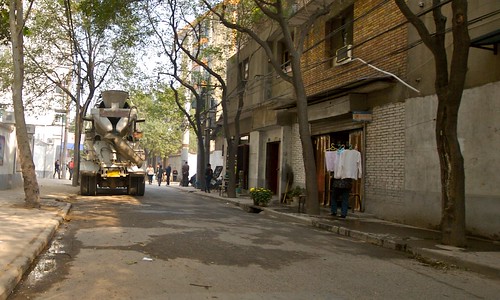
I was now in the real china. I walked a block too far to the north. Here I came across a school, with the children just heading off home. So I was quickly adopted by a few groups of school children. I was very impressed with their english and we played the game of you ask me a question in my language, and I will reply in yours. This is a game that is impossible to play in Australia as children are taught that all strangers are a safety risk.
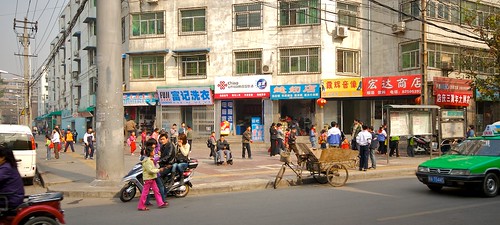





As I travelled along, I get several positive responses from the adults. Eventually they got a child to ask where I was going. I explained that I was headed to the 8 immortals temple. The child seemed genuinely disappointed. I explained that I was going there to take photos. I did not say that my guide book said that it was the last remaining temple of it's type in China. Though I do not believe this claim. By now the older boys were in on the act and they arranged for one of them to take me to the temple. I had gone a little to far and needed to back track about 150 meters to the temple.
The temple had the usual shopping area opposite with religious items but internally was quite empty and had only minimal upkeep.
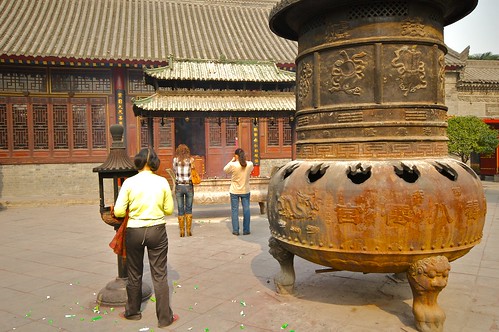










Heading back into town, I came across some Chinese playing mahjohng. The old man is delighted and the woman is trying to hide. At the wall there were also some people playing pool.
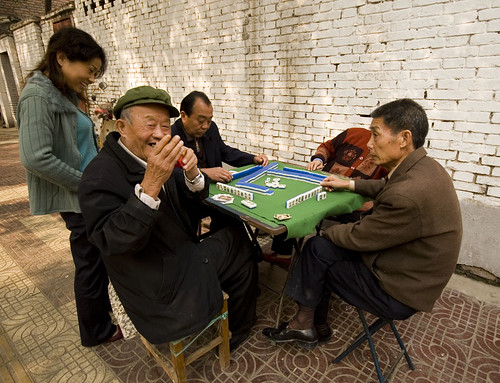





Back inside the city, I find this advertisement and have to take a photo and laugh.
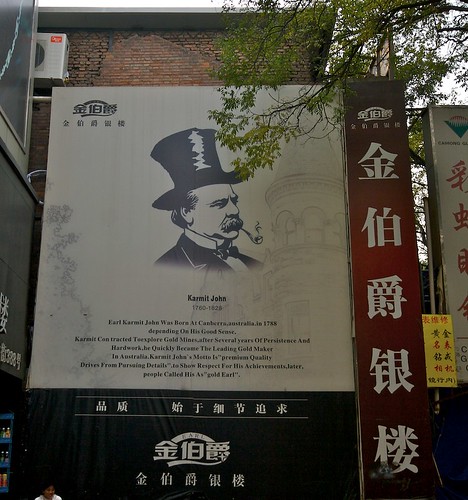
"Kermit John"
Kermit John was born in Canberra Australia and 1788 depending on his good sense.
Kermit contracted to explore gold mines. After several years of persistence and hard work, he quickly became the leading gold maker in Australia. Kermit John's motto is premium quality derives from pursuing details. To show respect for his achievements later, people called his as "gold earl".






We then headed back into Xian via the south gate, to the calligraphy market. By this time I had split off from most of the rest of the group and at the end of the market I headed off on my own. This part of town is still quite touristy.






I wound my way along the inside of the east wall, and up to the east gate. As I passed a hair dresser's I caused quite a stir with my long, unkept hair. I should have stopped for a hair cut.






Passing out through the gate, I wandered through the back streets. I was impressed again to see how far china has come. I saw my first cement truck in China. I remembered many years ago, watching a road be built in Le Shan in Sze Chuan province. There must have been at least 100 men. There were men shovelling the sand, screening and concrete into little mixers, much smaller than the one on a concrete truck. More men, took this away in wheel barrows, while others used trowels to put the concrete onto the road. The white lines were hand layed tiles. It was amazingly labour intensive.

I was now in the real china. I walked a block too far to the north. Here I came across a school, with the children just heading off home. So I was quickly adopted by a few groups of school children. I was very impressed with their english and we played the game of you ask me a question in my language, and I will reply in yours. This is a game that is impossible to play in Australia as children are taught that all strangers are a safety risk.






As I travelled along, I get several positive responses from the adults. Eventually they got a child to ask where I was going. I explained that I was headed to the 8 immortals temple. The child seemed genuinely disappointed. I explained that I was going there to take photos. I did not say that my guide book said that it was the last remaining temple of it's type in China. Though I do not believe this claim. By now the older boys were in on the act and they arranged for one of them to take me to the temple. I had gone a little to far and needed to back track about 150 meters to the temple.
The temple had the usual shopping area opposite with religious items but internally was quite empty and had only minimal upkeep.











Heading back into town, I came across some Chinese playing mahjohng. The old man is delighted and the woman is trying to hide. At the wall there were also some people playing pool.






Back inside the city, I find this advertisement and have to take a photo and laugh.

"Kermit John"
Kermit John was born in Canberra Australia and 1788 depending on his good sense.
Kermit contracted to explore gold mines. After several years of persistence and hard work, he quickly became the leading gold maker in Australia. Kermit John's motto is premium quality derives from pursuing details. To show respect for his achievements later, people called his as "gold earl".
Subscribe to:
Posts (Atom)